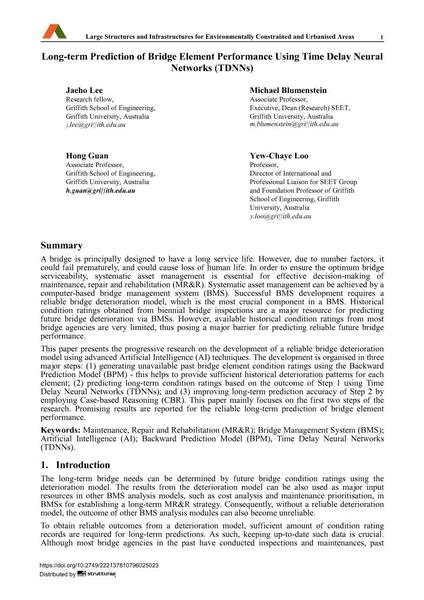Long-term Prediction of Bridge Element Performance Using Time Delay Neural Networks (TDNNs)

|
|
|||||||||||
Détails bibliographiques
| Auteur(s): |
Jaeho Lee
Michael Blumenstein Hong Guan Yew-Chaye Loo |
||||
|---|---|---|---|---|---|
| Médium: | papier de conférence | ||||
| Langue(s): | anglais | ||||
| Conférence: | IABSE Symposium: Large Structures and Infrastructures for Environmentally Constrained and Urbanised Areas, Venice, Italy, 22-24 September 2010 | ||||
| Publié dans: | IABSE Symposium Venice 2010 | ||||
|
|||||
| Page(s): | 374-375 | ||||
| Nombre total de pages (du PDF): | 7 | ||||
| Année: | 2010 | ||||
| DOI: | 10.2749/222137810796025023 | ||||
| Abstrait: |
A bridge is principally designed to have a long service life. However, due to number factors, it could fail prematurely, and could cause loss of human life. In order to ensure the optimum bridge serviceability, systematic asset management is essential for effective decision-making of maintenance, repair and rehabilitation (MR&R). Systematic asset management can be achieved by a computer-based bridge management system (BMS). Successful BMS development requires a reliable bridge deterioration model, which is the most crucial component in a BMS. Historical condition ratings obtained from biennial bridge inspections are a major resource for predicting future bridge deterioration via BMSs. However, available historical condition ratings from most bridge agencies are very limited, thus posing a major barrier for predicting reliable future bridge performance. This paper presents the progressive research on the development of a reliable bridge deterioration model using advanced Artificial Intelligence (AI) techniques. The development is organised in three major steps: (1) generating unavailable past bridge element condition ratings using the Backward Prediction Model (BPM) - this helps to provide sufficient historical deterioration patterns for each element; (2) predicting long-term condition ratings based on the outcome of Step 1 using Time Delay Neural Networks (TDNNs); and (3) improving long-term prediction accuracy of Step 2 by employing Case-based Reasoning (CBR). This paper mainly focuses on the first two steps of the research. Promising results are reported for the reliable long-term prediction of bridge element performance. |
||||
